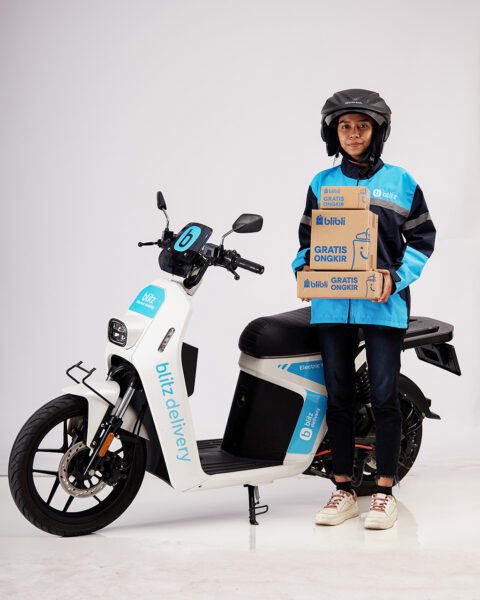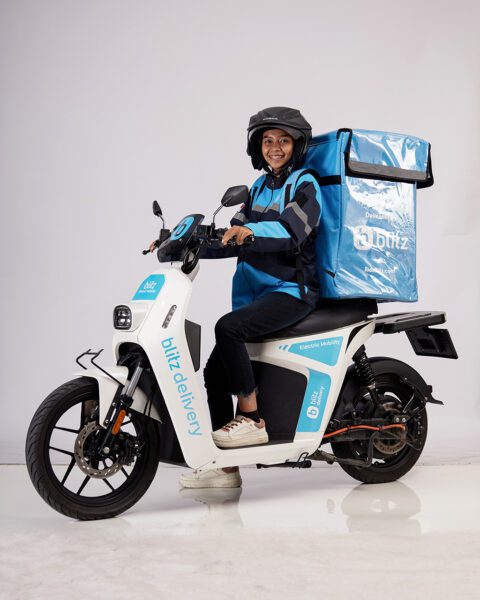From Survival Mode to Thriving
Rewiring (or unlocking) the MENA business mindset
Indonesia’s Blitz is reshaping delivery with EVs, AI, and a driver-first model

Blitz is tackling three major pain points in Indonesia’s logistics sector: inefficient last-mile delivery, low incomes for gig workers, and rising transport emissions. Through an integrated, AI-powered electric vehicle (EV) platform, Blitz is not only improving delivery times but also significantly raising drivers’ earnings and reducing carbon emissions.
“Logistics costs in Indonesia are among the highest in Southeast Asia,” says Blitz CEO Saivya Chauhan. “Deliveries often take two to four days. Gig workers are underpaid, and 99 percent of vehicles still run on gasoline.” Blitz aims to address all three challenges systematically.

Blitz CEO Saivya Chauhan
Blitz has built Southeast Asia’s first full-stack EV logistics platform, designed to integrate with partner systems seamlessly and enable instant deliveries. This tech infrastructure tackles delivery inefficiencies while supporting rapid scaling.
Second, the platform channels more revenue to drivers and offers the stability of full-time employment — providing access to EV financing, insurance, healthcare, and pensions.
Third, by operating an all-electric fleet, Blitz significantly cuts urban transport emissions.
Blitz’s logistics engine is powered by machine learning and AI, deployed at three key stages: pickup, routing, and return.
Before a delivery even begins, the system analyzes driver behavior, weather conditions, item fragility, and historical performance to assign the optimal driver.
For routing, Blitz compares Google Maps projections with its own route suggestions to optimize speed and efficiency.
And on the return leg — often a costly, empty-handed journey — the system scans for reverse logistics opportunities, such as return items or warehouse-bound packages, thereby maximizing vehicle use and reducing emissions.
 Carving out competitive advantages
Carving out competitive advantagesBlitz faces competition from both large conglomerates and smaller startups, but Chauhan sees two key differentiators.
“Most of the competition is B2C, while we are B2B,” he explains. “It’s very difficult for a B2C company to overhaul its infrastructure to match our delivery speed.” In fact, many of Blitz’s clients are large logistics firms that might otherwise be competitors.
The other advantage is proprietary technology. “We’ve built our entire tech stack in-house, and it’s been recognized internationally — including by Nvidia,” Chauhan adds.
Blitz has rapidly expanded across every Tier One city in Indonesia and many Tier Two cities. Its 60+ enterprise clients include a global pizza chain, international logistics companies, regional e-commerce platforms, and major social media firms.
Revenue has grown from under US$100,000 in 2022 to $3 million in 2024, with projections of $10 million in 2025. Blitz expects to grow its driver network from 1,000 to 9,000 by the end of this year.
Today, Blitz says it is the largest player in Southeast Asia’s instant delivery market — and holds the highest market capitalization in the region. After consolidating its presence in Indonesia, the company plans to expand internationally starting in 2026.
 An impact-first business model
An impact-first business model“Impact is critical to me — not just professionally, but personally,” says Chauhan. The company was born during the COVID-19 pandemic, when Chauhan noticed that gig workers were earning less despite booming delivery demand. “The platforms were predatory, taking more margin from the drivers. That sparked the idea of building a driver-centric platform.”
Blitz measures its impact in two key ways. The first is straightforward: carbon emissions reductions via EV adoption. The second is more personal: transforming drivers’ lives.
Blitz-financed drivers earn about US$266 per month, a nearly 30% increase over the industry average of $200. “That may not sound like a lot,” Chauhan notes, “but for drivers living hand-to-mouth, it makes a huge difference.” With benefits like health insurance, pension plans, and cheaper EV financing, Blitz is redefining what gig work can look like in a just and regenerative economy.
“I hope we inspire other founders to go in the same direction,” Chauhan says. “Impact startups deserve to be at the center of the next economic wave.”
Related Content
Comments
Deep Dives

Featuring
Clarisse Awamengwi
IE Correspondent
July 17 - 12:00 PM EST

Featuring
Russell McLeod
July 24 - 12:00 PM EST
RECENT
Editor's Picks
Webinars
News & Events
Subscribe to our newsletter to receive updates about new Magazine content and upcoming webinars, deep dives, and events.
Become a Premium Member to access the full library of webinars and deep dives, exclusive membership portal, member directory, message board, and curated live chats.
At Impact Entrepreneur, we champion fearless, independent journalism and education, spotlighting the inspiring changemakers building the Impact Economy. Diversity, equity, sustainability, and democracy face unprecedented threats from misinformation, powerful interests, and systemic inequities.
We believe a sustainable and equitable future is possible—but we can't achieve it without your help. Our independent voice depends entirely on support from changemakers like you.
Please step up today. Your donation—no matter the size—ensures we continue delivering impactful journalism and education that push boundaries and hold power accountable.
Join us in protecting what truly matters. It only takes a minute to make a real difference.
0 Comments